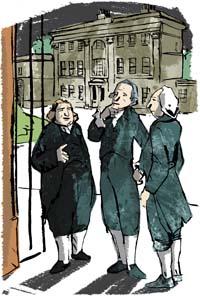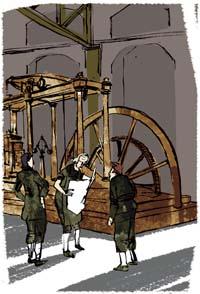The revolution of the lunatics

It was a clear and quiet full moon night. A large balloon rises up the sky full of an explosive mixture of air and hydrogen and hangs a long lit wick. Facing her, waiting for the essential explosion, some shadows: lunaticks. So were called every month those friends who met on full moon nights.
The wick is too long and, when it was no longer expected, was surprised by that explosion. About five kilometers from his friends, another lunatic who stayed home that night received him in writing: "The explosion was sudden and lasted about a second." These words belong to the famous James Watt, the father of steam engines. And those who played with the balloon were not any: Outstanding members of the Birmingham Moon Association. They tried to analyze the origin of the sound of thunder, and that of the globe was an experiment designed to test some of the theories they had in mind.
The sessions of the Moon Association were normally less bustling. Scientists, artists and industrialists gathered for dinner, to taste a good liquor and to talk long and long about machines, industry and science of the time and the future; or, as they said at that time, to talk about natural philosophy.
Erasmus Darwin, Matthew Boulton and William Small began to take place in the mid-1760s. Erasmus multifaceted, grandfather of Charles Darwin, was a fat, friendly and joking man, well known at the time. He was recognized as the best doctor in the area, but he was also a fertile inventor, chemist, physicist, botanist, meteorologist, philosopher and poet. Boulton, for his part, was a courageous and clear businessman, who dreams of making Birmingham the symbol of quality and founder of the successful Soho factory; and his doctor Small, very interested in engineering, chemistry and metallurgy.
Later, the other grandfather of Charles Darwin, the prestigious ceramist Josiah Wedgwood, James Watt himself, the chemist Joseph Pristley, the astronomer William Herschel, the industrialist John Wilkinson and the engineer William Murdoch met. Benjamin Franklin and Antoine Lavoisier also related to lunatics by letter and in the case of Franklin also with some visits.
Men of great prestige and tireless heads. Darwin himself, in addition to conducting a multitude of research and inventions, launched some ideas about the theory of evolution that the grandson would have developed with mastery. Pristley loved gases: he isolated oxygen and is the creator of soda. Herchel discovered Uranus. His performance was impressive.
In those meetings almost everything was spoken of, without order, without prior script and without limits, with complete freedom. The calacas were ferocious, sometimes crazy.

Darwin made clear the passion that these encounters lived in a letter written to Boulton and that he could not attend a meeting: "I am terribly sorry, because the gods of hell, who visit human beings with diseases and therefore constantly struggle with doctors, have not wanted to meet me today in Sohon with you, with those great men, Lord! What inventions, what occurrences, what metaphysical, mechanical and pyrotechnic rhetoric have been the word of this great group of philosophers! And in the meantime, I, the malevolent, I, prisoner in a car, without ends, without desire to escape and desperate, to wage war against syphilis or a bad fever!"
They were interested in science, but especially the applications of science. They envisioned the fast trains of the future, the large automated factories, the mechanized field lands, etc. Not only can you imagine, those ideas that emerged under the full moon went into action in many cases, and with the collaboration of the lunatics great advances were made. The Moon Association was, to a large extent, a squad of ideas from the industrial revolution. The world was changing and I knew. They were convinced that the work they were doing would improve the lives of the majority.
In this revolution, James Watt was an important character. The fury of hypochondria spent his 83 years thinking he was about to die. Contemporary writer Mary Ann Galton wrote that "it was a living portrait of melancholy. He used to have his head bent or leaning on his hand in meditation; his shoulders raised and his chest sunk." Few would think it was a genius.
After working as a tool maker apprentice, he began working as a tool arranger at the University of Glasgow. And when a damaged Newcom machine arrived in 1764 the fire was lit with steam engines.
By then, these steam engines created by Newcomen had been pumping water from coal mines for more than 50 years. But it cannot be said that they were very effective. In some large boilers the evaporated water pushed the piston upwards to the cylinder, and then, when cooled with cold water, it fell downwards again. These pistons went up and down five or six times per minute.
Watt realized that much of the heat generated in the boiler was consumed periodically heating the cylinder. And one afternoon on Sunday May 1765, strolling through a Glasgow park, the solution came suddenly: keep the cylinder warm and condense the steam elsewhere. The ride ended there.
He founded the first prototype and obtained the patent in 1769. And on his travels to London to get this patent, he began to stay in Birmingham to be with Darwin, Smalle and Boulton. The trio tried to convince Watt to travel to Birmingham and join them. And so he did, five years later, when his wife died and the protector of his machines failed.
The first Watt machine was not effective yet, since the technology of the time could not get the right cylinders. But Boulton had a blind trust in Watten, gave him money and a large human team working at his Soho factory.

The work of another lunatic was also fundamental in the development of steam engines. Known as John Wilkinson Iron-mad (Iron Madman), he endeavored to make iron things that until then had never been made of iron. He built the Wholverhampton chapel and built with iron the frames, pulpit and the seats of the chapel windows, not comfortable in winter. He also made the first iron barge, which said that everyone sank, but did not sink. His desk was made of iron and also made his own iron box.
In 1775, Wilkinson created a new drilling machine to manufacture better cannons. Until then they were made with cast iron, but drilling a solid bar got much better cylinders. And that was what Watt needed.
At the request of a Wilkinson cylinder, Watt got the first really efficient steam engine. The second went to the Wilkinson factory, and over the next 20 years Wilkinson manufactured cylinders for Boulton & Watt steam engines.
These machines were improving. Lunatic William Murdoch worked for Boulton and Watt in Sohon, who invented how to achieve a rotation movement with steam engines. The Soho factory became the icon of the industrial revolution, the Silicon Valley of the time. And his neighboring house Soho, residence of Boulton, was the most common meeting point of the Moon Association.
They remained with them until 1813. Every month, barely empty, and always sheltered from the full moon, they knew well the powers of the moon: the lunatics knew that the streets lit by the full moon were much more friendly and safe on the way from meeting to house.





